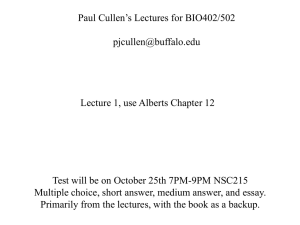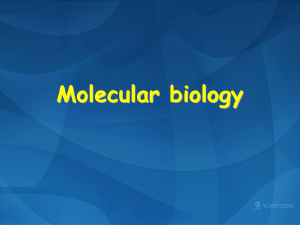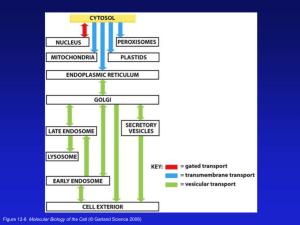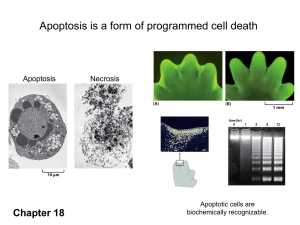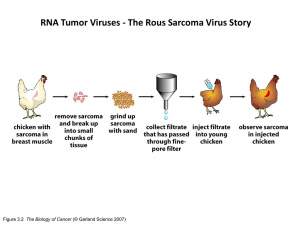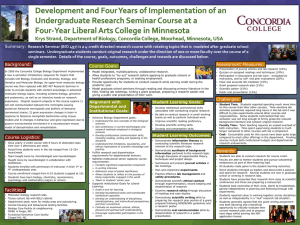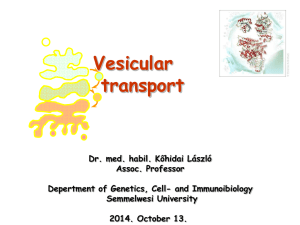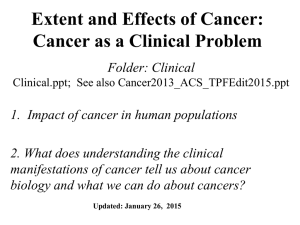590B_Lecture_2
advertisement
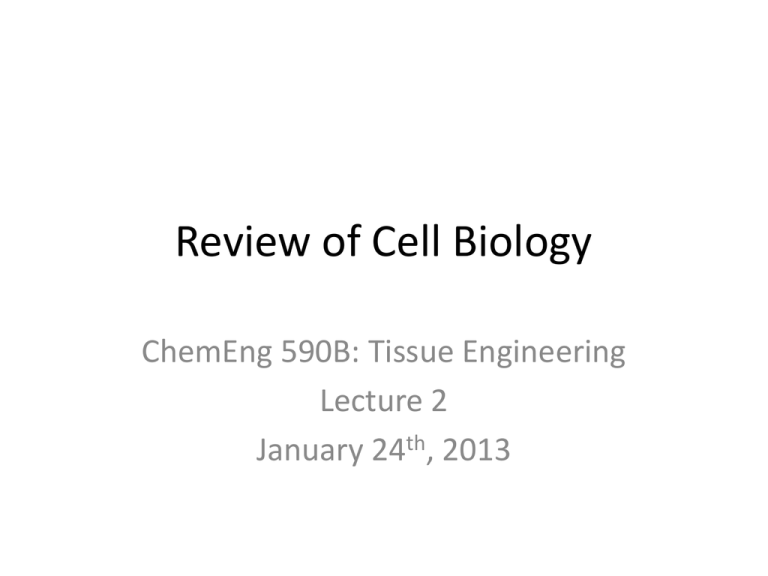
Review of Cell Biology ChemEng 590B: Tissue Engineering Lecture 2 January 24th, 2013 Animal Cell Structure 2 The Central Dogma of Molecular Biology 3 Figure 6-2 Molecular Biology of the Cell (© Garland Science 2008) 4 Figure 4-4 Molecular Biology of the Cell (© Garland Science 2008) 5 Figure 4-3 Molecular Biology of the Cell (© Garland Science 2008) DNA forms double helix G-C bonds are stronger than A-T bonds (3 hydrogen bonds versus 2) 6 Figure 4-5 Molecular Biology of the Cell (© Garland Science 2008) Not all DNA encodes for functional genes 7 Figure 4-15 Molecular Biology of the Cell (© Garland Science 2008) DNA-RNA Transcription 8 Figure 6-7 Molecular Biology of the Cell (© Garland Science 2008) RNA Polymerase 9 Figure 6-8a Molecular Biology of the Cell (© Garland Science 2008) DNA Selectively Separated and Transcribed 10 Figure 6-11 Molecular Biology of the Cell (© Garland Science 2008) RNA polymerase can read in both directions 11 Figure 6-14 Molecular Biology of the Cell (© Garland Science 2008) Many RNA Polymerases act at once 12 Figure 6-9 Molecular Biology of the Cell (© Garland Science 2008) RNA forms functional secondary structures 13 Figure 6-6 Molecular Biology of the Cell (© Garland Science 2008) 14 Table 6-1 Molecular Biology of the Cell (© Garland Science 2008) The Central Dogma of Molecular Biology 15 Figure 6-2 Molecular Biology of the Cell (© Garland Science 2008) Multiple Codons for most Amino Acids 16 Figure 6-50 Molecular Biology of the Cell (© Garland Science 2008) tRNA structure and codon translation 17 Figure 6-52 Molecular Biology of the Cell (© Garland Science 2008) Codons, Anticodons, and Wobbles 18 Figure 6-53 Molecular Biology of the Cell (© Garland Science 2008) Translation movement from N-C term. inside ribosome 19 Figure 6-66 Molecular Biology of the Cell (© Garland Science 2008) Multiple Ribosomes can be bound to RNA at once for rapid protein production 20 Figure 6-76 Molecular Biology of the Cell (© Garland Science 2008) Transcription can be internally regulated 21 Figure 6-3 Molecular Biology of the Cell (© Garland Science 2008) Transcription and Translation Compartmentalized 22 Figure 6-21a Molecular Biology of the Cell (© Garland Science 2008) 3rd layer of complexity: post-translational modifications 23 Table 3-3 Molecular Biology of the Cell (© Garland Science 2008) 24 Figure 3-81a Molecular Biology of the Cell (© Garland Science 2008) 25 Figure 3-81b Molecular Biology of the Cell (© Garland Science 2008) 26 Figure 3-81c Molecular Biology of the Cell (© Garland Science 2008) PROTEINS. Made from amino acid building blocks R 27 Figure 3-2 Molecular Biology of the Cell (© Garland Science 2008) R Small: peptide Long: proteins Single AA: monomer Protein: polymer Peptide Bond! 28 Figure 2-24 Molecular Biology of the Cell (© Garland Science 2008) From amino acids to proteins My favorite protein: RhoA (small GTPase) www.ncbi.nlm.nih.gov/protein Primary Structure maairkklvi vgdgacgktc llivfskdqf pevyvptvfe nyvadievdg kqvelalwdt agqedydrlr plsypdtdvi lmcfsidspd slenipekwt pevkhfcpnv piilvgnkkd lrndehtrre lakmkqepvk peegrdmanr igafgymecs aktkdgvrev fematraalq arrgkkksgc lvl Secondary Structure, a-helix and b-sheets Dictated by primary sequence, hydrogen and disulfide bonds “MALEK” Fully extended chains: NH-O 29 interactions, aromatic residues Protein structure, continued Tertiary structure of RhoA Final, folded protein conformation Dictated by secondary structure and remaining hydrogen, disulfide bonds Quaternary Structure: Dictated by tertiary and primary structure: What is the protein’s function? Shimizu T et al. J. Biol. Chem. 2000;275:18311-18317 30 Types of amino acid interactions 31 Figure 3-4 Molecular Biology of the Cell (© Garland Science 2008) Hydrophobic “collapse” This state is minimum Gibb’s energy in water 32 Figure 3-5 Molecular Biology of the Cell (© Garland Science 2008) Animal Cell Structure 33 Movement of proteins between organelles is tightly controlled 34 Figure 12-6 Molecular Biology of the Cell (© Garland Science 2008) Lipid monolayers create fat vacuoles 35 Figure 2-81a Molecular Biology of the Cell (© Garland Science 2008) Since Organelle Membranes are Lipid Bilayers, Vesicular Transport via Budding 36 Figure 12-7 Molecular Biology of the Cell (© Garland Science 2008) Lipids are long, saturated hydrocarbons 37 Figure 2-21 Molecular Biology of the Cell (© Garland Science 2008) Bioengineering Micelles for drug delivery Drug or molecule of interest Antibody for cell specificity, OR carrier to evade immune system Lipid bilayer will fuse with cell membrane, emptying cargo into cell 38 Nucleus DNA storage, synthesis, replication DNA tightly packed via histones into chromosomes (otw is 1.8m long!) Connected to cytoplasm via endoplasmic reticulum 39 Nuclear Pore Complexes are Tightly Controlled 40 Figure 12-9 Molecular Biology of the Cell (© Garland Science 2008) Very Small Molecules: Diffusion, Large Molecules are Shuttled 41 Figure 12-10 Molecular Biology of the Cell (© Garland Science 2008) Endoplasmic Reticulum RER: rough in appearance because ribosomes are attached to its membrane Amino acids shuttle from RER via ribosomes, which then fold into proteins in cytoplasm SER: not covered with ribosomes. Manufactures phospholipids and stores calcium ions – an important signaling activating ion. 42 RER and SER Connected 43 Figure 12-36c Molecular Biology of the Cell (© Garland Science 2008) Ribosomes quickly move on and off RER surface 44 Figure 12-38 Molecular Biology of the Cell (© Garland Science 2008) Golgi Apparatus Many proteins, through made in the RER, will pass through Golgi before reaching final destination. Has a Cis and Trans polarity. Cis faces the RER, and Trans faces cytoplasm. The Golgi helps direct proteins to their final destination Contains chaperone proteins, which help assemble proteins that don’t form tertiary structures on their own 45 Other small organelles Peroxisomes: oxidation reactions (important for some enzymes) Lysosomes: degrades damaged organelles, small organisms that have been phagocytosed, growth factors that bind to the cell surface and are endocytosed. Helpful small molecules are released into cytosol. Mitochondria: Produces ATP (the basis for all cell energy). Evolutionarily, the mitochondria was a bacteria, engulfed by an animal cell – now a symbiotic relationship. Mitochondria have their own DNA, organelles, and can replicate. 46 Cell Division: Overview Figure 17-1 Molecular Biology of the Cell (© Garland Science 2008) Cell Division Consists of Several Phases Figure 17-4 Molecular Biology of the Cell (© Garland Science 2008) Cell Division: Mitosis and Cytokinesis Figure 17-3 Molecular Biology of the Cell (© Garland Science 2008) Progression through cell cycle governed by checkpoints Figure 17-14 Molecular Biology of the Cell (© Garland Science 2008) Cytokinesis: Microtubule-mediated chromosome division Figure 17-28 Molecular Biology of the Cell (© Garland Science 2008) Cytokinesis: Microtubule-mediated chromosome division Figure 17-43 Molecular Biology of the Cell (© Garland Science 2008) Mitosis Figure 17-47 Molecular Biology of the Cell (© Garland Science 2008) Meiosis Division Limitation: Telomeres 54 Telomeres: DNA Replication Limiters 55 Multiple cell divisions leads to cell specialization Figure 17-67 Molecular Biology of the Cell (© Garland Science 2008) EC signals transduced via signaling proteins – to – transcription factors, finally altering phenotype Figure 15-1 Molecular Biology of the Cell (© Garland Science 2008) Paracrine Signaling: um in distance Figure 15-4b Molecular Biology of the Cell (© Garland Science 2008) Endocrine signaling: very long distance paracrine signals (hormones) Figure 15-4d Molecular Biology of the Cell (© Garland Science 2008) Final Items to Consider Thoughts for your grant assignment? • Given spatial and temporal sensitivity of soluble signals, how do we deliver factors through a biomaterial to engineer proper cell and tissue function? • Can soluble signals themselves model paracrine signaling, or do we need multiple cell types? • Can we engineer growth factors with longer life times to reduce the total amount we need to deliver (or continue to deliver over time)?
